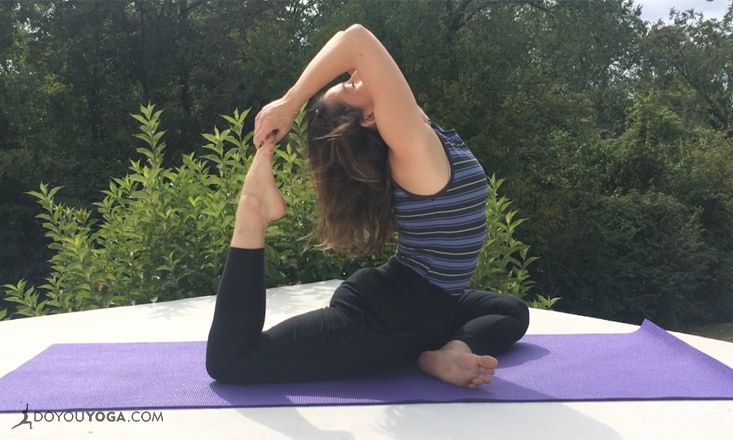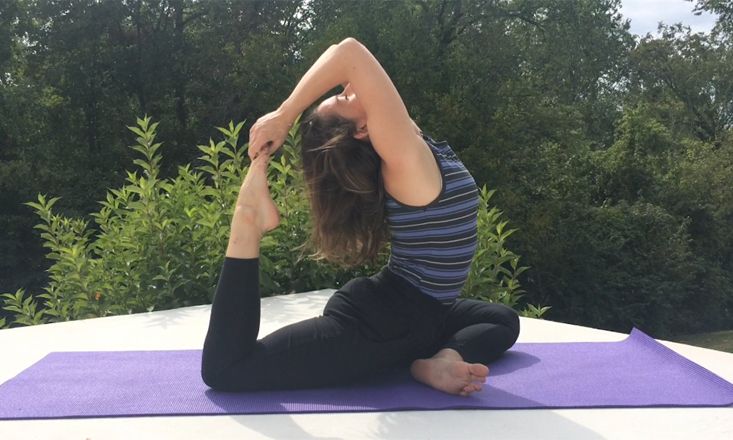Pigeon pose (Eka Pada Rajakapotasana) is an intermediate yoga posture that opens the hips and chest, stretches the quads, and provides a deep backbend. This complex asana carries both mental and physical benefits and a unique history.
The pose may have been named after an actual pigeon (kapota translates to pigeon in Sanskrit), as the full expression of the pose resembles a pigeon puffing up its chest. It may have also been named after a yogic master named Kapota, who was known for agility, strength, and vitality as documented in the Mahabharata scripture.
The Benefits of Eka Pada Rajakapotasana
Pigeon pose is ubiquitous in Western yoga classes as a go-to hip opener that has many benefits beyond stretching and strengthening the hips! Pigeon pose also stretches the quads and chest, and is a backbend depending on the variation you choose.
Pigeon pose helps to stretch the psoas muscle, the main hip flexor and connector of the torso and legs that becomes shorter due to a sedentary lifestyle. It also promotes the external rotation of the femur in the hip socket, allowing ligaments, tendons and muscles to lengthen and strengthen.
The full expression of the posture also stimulates organs and glands in the abdomen, all of which promote physical wellness. Mentally, Pigeon Pose helps you stay calm in stressful situations by activating the sympathetic nervous system when the “fight or flight” stress response is triggered.
Using Pigeon as the Peak Pose
Pigeon is often practiced at the end of a yoga sequence, primarily due to the body being warmed up from other postures by that point, and to focus on relaxing the mind and calming down toward more restful, end-of-practice postures.
The beauty of yoga sequencing is that it’s holistic, allowing the poses to work together by activating different areas in the body in preparation for a peak pose. Warming up the hips and back will keep help prepare the body for Pigeon pose and keep you safe in the full expression of the posture.
Please note: if you have knee injury or sacroiliac issues, pigeon pose should not be performed to avoid further injury. Also, our bodies are different, so you might need to build up to the full expression of Pigeon by practicing its variations and other postures.
Pigeon Pose Sequence
Before you begin, do five rounds of Sun Salutation A to warm up for the postures.
Bound Angle Pose
Also known as Baddha Konasana, this pose helps you explore external rotation in the hips. Bend forward for a deeper stretch in the hip flexors. Find gentle movements to explore the posture, and hold the pose as long as you need.
Downward Dog Variation: Three-Legged Dog
This Downward Dog variation (adho mukha svanasana) allows you to explore your hip flexibility, increase circulation to the hips, and prepare them for a deeper stretch. It is also a great way to stretch the arms, chest, and back.
Crescent Lunge
Anjaneyasana helps to stretch the psoas, quads, and prepare the hips for deeper movements. The pose also opens the chest and offers a gentle backbend to prepare for a deeper bend. The duality of push and pull in this pose helps prepare you for the push and pull in pigeon pose.
Warrior II
Virabhadrasana II helps you cultivate focus and does a great job of warming and opening the hips and lengthening the upper and lower body. Hold the pose for at least one minute to power up for other poses.
Thread the Needle
This is a great way to engage the psoas and externally rotate the hips. If Pigeon pose is ever inaccessible to you, this variation gives you similar benefits in a supine position.
Pigeon Pose
The peak pose! You have the option of laying forward for a more restorative posture, staying upright with a slight backbend, or going for the full expression by reaching your hands back and bending the back foot up, grasping onto the toes.
You may also use a mat or block to place under the hips to provide extra support. Each level is beneficial—find where you fit best, and focus on building the pose for your body.
Knees to Nose
Return to a supine position and hug the knees toward your chest. To make it extra yummy, rock back and forth to massage and release tension in the spine.
Reclined Twist
A reclined twist will help release tension by stretching the outer hip and giving the spine a gentle twist.
To finish off, try a brief meditation in a comfortable seated posture or relax in Savasana. Focus on the effect the practice has cultivated by doing a body scan from the toes to the top of the head.
And remember, each body is different and requires different movements depending on the day. Respect your own limits and give your body the mindful movement it deserves to gain the most from this sequence.










